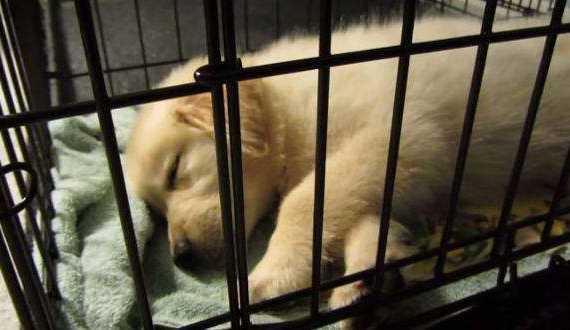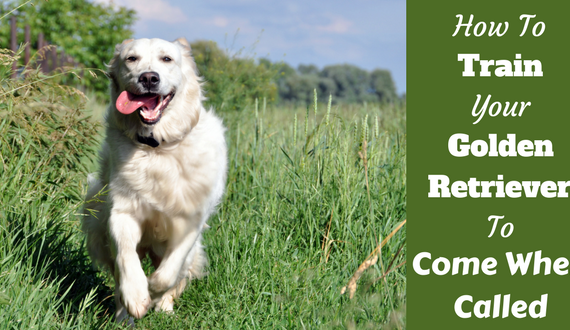Updated: August 9th, 2022

© Depositphotos.com / JFJacobsz
Hey there! I’m Perrin from HerePup.com. I just finished crate training my dog, Chewie, about three months ago and I wanted to share a few things I learned along the way.
Like any form of training, crate training takes time. In fact, sometimes more than you bargained for because it’s not simply learning a trick—it’s asking your dog to enjoy time alone when they’d much rather spend every minute with you!
Because of this there’s going to be some whining, barking, and crying, but if you’re going to get your pup acclimated to her crate and time alone, you simply have to ignore her puppy protests.
And I don’t know about you, but it absolutely sends my heart rate through the roof when my dog is crying and I’m purposefully ignoring her. My parental instinct goes into overdrive, and I almost have to tie myself to a chair to keep from jumping to reassure her.
In other words, it can be stressful and feel like a lot of work. So how in the heck do you manage to do it with a full-time job?
In my view, the best solution is try to do it over a single weekend. Lots of guides recommend you devote a week or more to crate training a dog, but unless they have separation anxiety or some medical condition that makes staying in a crate difficult (e.g. UTI, digestive problems), she may be able to learn it in a bit less time. Here’s a quick guide.
First Things First: Standard Rules of Crate Training Still Apply
If you’re totally new to crate training, check out this great guide from Totally Goldens here, which outlines the process in great detail. But here’s a quick recap of the major takeaways that should also be applied to weekend crate training:
Make The Crate Comfortable.
Ideally, your dog’s crate will become a place where she loves to hang out. Even better, it will become her own space—a private little sanctuary that feels safe and comfortable. You can help this along by making sure she’s got pillows, blankets and toys there. You also want to make sure it’s out of direct sunlight.
Use Positive Reinforcement To Make The Crate A Happy Place.
In the guide mentioned above, we use the “treat fairy” method, where you put treats in your pup’s crate when she’s not around, so they “magically” appear and she gets to find them.
Personally, my dog is much more affection-motivated than she is treat-motivated. When we were crate training her, we’d set aside a few minutes throughout the day for “crate therapy,” where we’d give her a huge helping of love and a full doggy massage either by her crate or inside it. Either works. You just want to start forming those positive associations.
Feed Your Dog Inside The Crate.
You’re going to be feeding your dog anyway, and meal time is probably one of your dog’s favorite times of day, so use that energy to create a strong positive association. If your pup is reluctant to go all the way in the crate, it’s usually fine to place the bowl just inside the door (at least to start).
Heed The “Don’ts.”
There are few things you shouldn’t do when crate training your dog:
- Don’t ever put your dog in a crate for longer than she can hold her bladder.
- Don’t put her in there with her leash or collar on (choking hazard).
- Don’t ever put dogs with severe anxiety in a crate.
- Never put a sick dog in a crate, especially if she has stomach problems.
- Don’t put your dog in a crate when it’s super-hot or super-cold.
- Never crate your dog as a punishment or to get them out of the way.
- Never crate a lonely dog.
Okay… now that we’ve taken a recap of the basics, let’s chat about how you might crate train your dog in a weekend!
A Weekend Crate Training Schedule
Friday Night
Prepare The Crate.
You’ll want the crate to be in the same state when you start the training as it is when you ask your dog to go in and sit down. You don’t want to switch it up on her, or she may get confused. So, the first thing you should do is prepare the crate with bedding, toys, and whatever else your dog will have in there.
Play The Treat Fairy.
Remember the treat fairy from our previous guide? That’s when you wait until your pup isn’t looking and toss a few treats into the crate for her to find. There are a couple of key reasons why this works:
- The crate itself becomes the thing that provides treats.
- She’s free to come and go as she pleases, which greatly reduces the risk of anxiety.
Feed Your Dog In Her Crate.
When it’s dinner time, feed your pup in her crate. Like we mentioned above, you’ll want to place the bowl just inside the crate door, especially if your dog is still apprehensive. If she seems fine, nudge the food back a bit and see if she’ll go all the way in.
That’s it!
Friday night should be almost entirely about positive, food-based reinforcement. You don’t need to worry about getting your dog in the crate just yet, and certainly not closing her in. You just want her to have visions of kibble dancing in her head when she walks by her crate door.
Saturday
Toss Treats In The Crate.
Toss a treat in the crate and let your dog follow her nose in there to retrieve it. When you do this, make sure to use whatever cue word you’re going to use to ask your dog go into her crate.
So for example, you might toss a treat into her crate and say, “Crate.” When she goes in for the treat, praise her like there’s no tomorrow. Repeat this 10 or 20 times throughout the day, or until your pup is reliably entering the crate for the treat.
Make Her Work For The Treat.
After your dog is going into the crate on her own, you want to make her work for the treats. Use your cue word (e.g. “Crate”) and wait for her to go in there. When she does, reward her with a treat. If you’ve done any training with her before, she’ll probably recognize this pattern of learning pretty quickly (and even get excited). Do this about a dozen times or until your pup is “earning” her treat reliably.
Close The Door.
The goal here is not to leave your dog alone in the crate. It’s simply to get her used to the door closing by using positive reinforcement as a buffer. Like with any training progression, warm up by doing something she already knows: send her to her crate and give her a treat. After she’s warmed up, send her into her crate, praise her right away, and give her a treat. While she’s eating the treat close the door for a second or two and open it, praising her again.
Repeat this a dozen times or so and take a break. Then, do it again. Personally, I like to really dive into this step, since I find closing the door the biggest obstacle.
Close The Door And Sit Nearby.
After your pup can comfortably go into her crate with the door closed, try repeating the same process but gradually increase the time the door is closed and move away slightly, sitting nearby. Switch up the length of time she’s in the crate: 15 seconds, 10 seconds, 20 seconds, then perhaps a super short 3-seconds.
Leave The Room.
For the next exercise, warm up by crating your dog, closing the door, latching it, and giving her a treat after it’s closed. Then, you’re going to repeat the process, but you’re going to leave the room for a few seconds at a time. If possible, try to leave the room through a different door each time, so your dog doesn’t associate a particular door with her crate.
Sunday
Longer Crate Times With Fun Toys.
Warm up with a few of the exercises from yesterday using small, normal treats (or perhaps even a few pieces of kibble). Then, crate your dog, give her a really stimulating toy (like a Kong), close the door, and just hang out in the same room for 30 minutes or so.
It’s very important not to reward your dog for coming out of her crate. You want to reward her for being quiet and polite inside her crate. Generally, when your pup comes out of her crate, don’t pay much attention to her for a few minutes (this reduces her excitement).
Wear That Pup Out!
Before you go for some extended alone time, make sure our dog is totally beat. A jog, a trip to the dog park, a romp with a playmate—doesn’t matter. Just get her nice and tired. It’ll make the next step about a hundred times easier.
Crate Her And Leave The Room.
When your pup’s nice and tired, crate her, give her a chew toy (or whatever she likes to play with) and leave the room completely. As always, don’t let her out if she whines. She can only come out if she’s been quiet for a few moments. After 10 minutes or so, take a quick break and try again.
Leave The House.
If your dog’s gotten this far, this step should be a little easier than the rest. Basically, just repeat the previous step, but this time, leave the house instead of leaving the room. Don’t tell your dog “Bye,” and don’t make a fuss. It should be totally unceremonious. Leave for 10 minutes, come back, take a break and repeat.
Go To Sleep.
If your dog’s comfortable with you leaving the house, you can try crating her at night.
As always, you want to make sure she’s good and exhausted to make her more likely to relax. You can give her a treat or a bone if you like (just be careful with dogs who have a heavy burying instinct, since they can get stressed if they don’t have a place to bury excess food).
Crate your dog and go to sleep. If she whines, ignore her completely (this is the toughest part for me, but it’s necessary; you don’t want to reward your dog for whining, and you certainly don’t want to reward her by letting her out of her crate).
And That’s It!
If you’ve gotten all the way through the above steps, your dog is probably good to go. If you got hung up at any point, don’t sweat it! Just return to the previous step where your dog was successful before moving forward again.
Many older dogs can be crate trained this quickly, in just a weekend. Give it a try, you might be pleasantly surprised!
Further Information:
Crate training with a full-time job can be difficult so in my humble opinion, everybody should try to achieve it in a single weekend by following the steps above. Many will find success, though of course many won’t.
If your dog doesn’t take to it so easily, Totally Goldens has some other great guides to help you which you can find right here:
- A detailed guide to crate training your puppy or dog
- What to put in the crate with your dog and should you cover it?
- Dog crate sizes: How to choose the right crate for your dog.
- There are times when you should not crate your dog: Here’s when!



